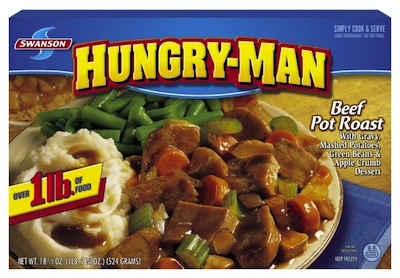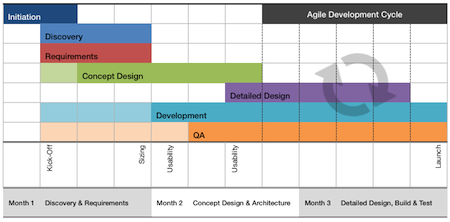The Hungry Man: Lean UX Process for the Enterprise Design Team
4 Jun, 2013Increasingly, designers were spending more time creating documentation that developers didn’t have time to read
The Waterfall process was broken. Experienced practitioners of information architecture, user interface design, and software development were experiencing it first hand. The process was no longer able to keep up with the increasing demands of product owners whose need for new features & enhancements were matched only by the pressure to release those new features to customers as quickly as possible. Increasingly, designers were spending more time creating documentation that developers didn’t have time to read.
The adoption of Agile software development helped technology teams build and release updates more quickly, but designers began to feel like they were simply designing for sprints—unable to step back and think holistically about the effects of the updates on an overall product.
Lean UX, a process described by designer Jeff Gothelf, presented a path forward for designers to work very collaboratively with product owners and developers. It emphasizes very light documentation and a focus on rapid prototyping & testing in order to kick the tires on designs as quickly as possible. Lean UX is a great method in the right environment e.g. co-located teams, start-ups, web-based software. It can be a challenge in larger organizations where teams are distributed, more reliant on documentation, and work toward specific release cycles.
Enter The Hungry Man

Many of us who work on design teams for large companies see the value of operating in a Lean environment, but the nature of our corporate infrastructures make the approach untenable. Teams may be distributed across different countries and varying time zones. Software releases may be scheduled quarterly rather than ad hoc. And politics often require documentation that can travel up the corporate food chain. Rather than resorting to Waterfall (an approach that is out of touch with modern software development), I propose a middle ground inspired by Lean UX: The Hungry Man.
The Hungry Man was envisioned to allow distributed teams to work as collaboratively as possible on a range of product features & enhancements during a quarterly release cycle.
The process begins with Project Initiation which may include staffing allocations, a project brief to describe the upcoming work stream, and a cross-functional team kick-off meeting to align everyone’s expectations on the proposed goals of the release cycle.
Discovery and Requirements tracks, which include user research, competitive evaluations, content strategy, and documentation of business & functional requirements and systems analysis lead into a conceptual design phase.
Requirements and analysis should be concluded prior to Concept Design beginning in earnest
During Concept Design we use the information gathered during Discovery and Requirements to envision our product holistically in order to clearly understand how any changes will effect/improve it. The design team will lead sketching sessions (based on documented goals and requirements) that focus on user flows, architecture and low-fidelity UI design. As much as possible, these rough ideas should be made into early prototypes to be shared and vetted with business and technical partners, and customers. The design concepts combined with business goals and requirements should provide enough information for teams to understand what’s on their plate (pun intended, it’s called Hungry Man, right?) for the release cycle and size the overall effort.
Activities during the Concept Design phase will continue—fleshing out, testing, and validating additional details in order to arrive at a point of clarity in terms of functionality and interface design. The technology team can also get a jumpstart on any architectural systems development (database, APIs & services) while the UI is being finalized, and design specs start to be produced. As Concept Design comes to a close the teams will meet to divide the remaining work into manageable portions (Salisbury Steak, Peach Cobbler, Green Beans, etc.) that will be scheduled into the upcoming sprint cycles as the teams transition into the detailed design & build phase.
During Detailed Design & Development teams work in traditional sprint cycles with designers delivering specifications and production assets to their development partners in a “just in time” delivery approach. In other words, designers should be working 1 to 2 weeks ahead of development sprint cycles in order to provide specs and assets in time to be incorporated into code. QA testing and design fit & finish reviews will occur regularly throughout this cycle up until the release is ready for launch.
The Hungry Man is obviously intended to scale and overlap so that Discovery and Concept Design can begin again for an upcoming release (2.2) while Detailed Design and Development are occurring for the current release (2.1).
A few notes on how to successfully implement the Hungry Man:
- Requirements and analysis should be concluded prior to Concept Design beginning in earnest. This will reduce the amount of design rework required due to technical limitations and/or requirements changing
- Concept designs should start with sketches (include all internal stakeholders in early sketching sessions) and evolve into more polished work as you near the end of this phase. Socialize the work as much as possible with internal stakeholders
- Prototypes should be able to be built and validated by designers with the variety of prototyping tools available (Proto.io, TAP, InVision, Pop, Axure, Keynotopia, etc.). Any code produced by these tools is not intended for production
- Use prototypes to test design concepts with users at least twice during the Concept Design phase in order to make refinements and finalize the approach prior to the beginning of the Detailed Design and Development phase
- Create only as much documentation as is necessary for your corporate culture and to adequately communicate how to implement the design
- Technology will likely lead the discussion in terms of Hungry Man portions and the order in which they will be built during the Detailed Design and Development phase
- A well organized content repository open to all team members that can post and store documents with version control and a good search engine can be a great way to ensure everyone has access to the most up-to-date information. The Confluence platform is a great tool to help facilitate collaboration among distributed teams
The Hungry Man is designed to allow cross functional teams to conceptualize the bigger picture collaboratively while portioning off design and development work incrementally, all while maintaining a level of documentation that your internal culture requires.
Design hungrily!
Posted in Design | Comments Off on The Hungry Man: Lean UX Process for the Enterprise Design Team
